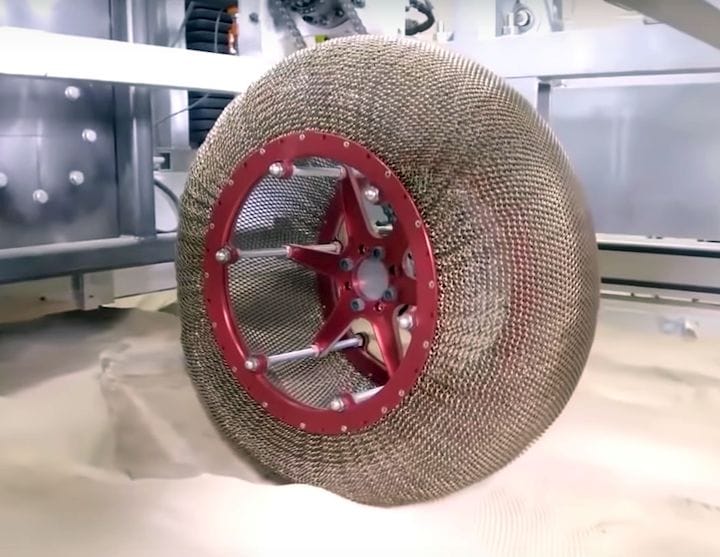![NASA developed a reusable wheel using shape memory alloys [Source: Interesting Engineering]](https://fabbaloo.com/wp-content/uploads/2020/05/image-asset_img_5eb0a62807129.jpg)
After watching a fascinating video about shape memory alloys, I realize there are many possible 3D print applications.
The video, produced by Interesting Engineering, shows how NASA “reinvented the wheel” using a shape memory alloy. The space agency discovered trouble on its Mars rover Curiosity when sharp rocks were knocking out chunks of its thin metal wheels. For subsequent missions they require a similarly light wheel, but one that can withstand the arduous surface conditions.
They opted for a kind of wire-mesh wheel made from a very special alloy. Normal metals would deform permanently upon the stress of traversing a big rock, making their lifetime rather short. But by using a shape memory alloy, the deformation can be immediately undone.
In their case, NASA used something call Nitinol, an alloy of nickel and titanium. This unusual combination has the aforementioned shape memory effect: it can deform, but when exposed to heat, it will restore its original shape.
![NASA made their Mars rover wheel using conventional CNC machining [Source: Interesting Engineering]](https://fabbaloo.com/wp-content/uploads/2020/05/image-asset_img_5eb0a6283a794.jpg)
The action occurs at a molecular level, where the atomic bonding forms a crystalline structure that can bend without unbending. Heat restores it to the original shape.
But it turns out that by manipulating the ratio of elements, that activation temperature can be adjusted and even specifically designed. In the case of the wheel design, they developed a material that would obtain the restoration heat simply through normal use of the wheel, perhaps through friction or the heat of pressure.
![A prototype “space wheel” by NASA made from shape memory alloys [Source: Interesting Engineering]](https://fabbaloo.com/wp-content/uploads/2020/05/image-asset_img_5eb0a62869488.jpg)
This is great, but let’s now think about how 3D printing could make use of this concept.
3D printing could be used to create incredibly complex geometric structures that could include “flexible” elements using the shape memory alloy. The number of “solid” machines using this approach could be near infinite. It’s not clear what the lifetime of such machines could be, but it could be more than if using conventional assembly approaches.
Another very intriguing possibility is taking control of the temperature effect. While many metal 3D printers require the use of a single material (or alloy) during a print job, some processes do not. Some metal 3D printing processes that jet powder can potentially alter the powder mix on the fly. One example of this is Aurora Labs’ first metal 3D printer.
![Bending a shape memory alloy that can be restored to its initial shape with heat [Source: Interesting Engineering]](https://fabbaloo.com/wp-content/uploads/2020/05/image-asset_img_5eb0a6289bbe4.jpg)
Imagine a highly complex design in which the structures mentioned above would restore their original shape but in a manner controlled by temperature. The structure could activate in a progressive sequence, for example. One application could be to open vents more as the temperature rises. An opposing mechanism could close the vents as temperature drops. You get the idea.
I don’t believe this area has been sufficiently explored, and more research is surely required. I imagine there could be countless possible applications of this approach, perhaps leading to a world in which “solid machines” are commonplace in a distant future.
But the journey there will take many years.











Aerosint and Aconity have proven out their work in multi-metal powder deposition 3D printing.